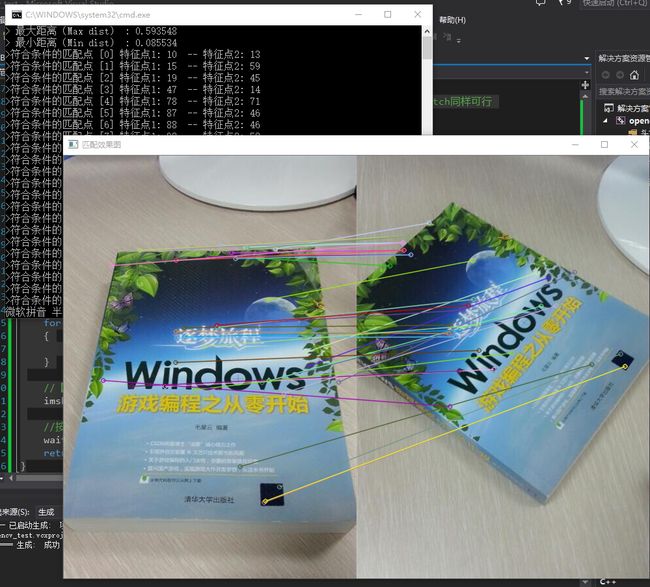- windows python opencv imshow图片报错解决
热爱生活热爱你
python3opencv人工智能计算机视觉
importcv2#检查版本print(cv2.__version__)#加载一张图片(确保你有一个名为'test.jpg'的文件在当前目录)image=cv2.imread('C:\\test1.jpg')#显示图片cv2.imshow('image',image)cv2.waitKey(0)cv2.destroyAllWindows()cv2意思是opencvc++o(* ̄︶ ̄*)o建议使用A
- OpenCV 深度学习模块 cv2.dnn 与其他深度学习框架的优缺点对比及适用场景
白.夜
深度学习opencv
OpenCV提供了一个深度学习模块cv2.dnn,让开发者能够在计算机视觉项目中轻松加载和推理深度学习模型。相比于TensorFlow、PyTorch等其他深度学习框架,cv2.dnn有其独特的优点与缺点,适用于不同的应用场景。在这篇文章中,我们将详细分析cv2.dnn的优缺点,并讨论它的适用场景。一、cv2.dnn的优点1.简单易用cv2.dnn提供了一个相对简单且易于使用的接口,适合已经在使用
- 深度学习中的 blob 格式:与普通 image 的区别及转换原因
白.夜
深度学习人工智能
在深度学习模型推理过程中,我们经常会用到cv2.dnn.blobFromImage函数将普通图像转换为blob格式。那么,blob格式到底是什么?它和普通image有什么区别?为什么在模型推理中需要这种转换?本文将用通俗的语言为你解答这些问题。1.什么是blob格式?blob是OpenCV中用于深度学习模型输入的一种特殊数据格式,全称为BinaryLargeObject。它本质上是一个多维数组(通
- python opencv轮廓检测_python opencv中的不规则形状检测和测量
weixin_39584529
pythonopencv轮廓检测
正如我在评论中提到的那样,对于这个问题,分水岭似乎是一个很好的方法.但是当你回答时,定义标记的前景和背景是困难的部分!我的想法是使用形态梯度沿着冰晶获得良好的边缘并从那里开始工作;形态梯度似乎很有效.importnumpyasnpimportcv2img=cv2.imread('image.png')blur=cv2.GaussianBlur(img,(7,7),2)h,w=img.shape[:
- OpenCV学习(二十一) :计算图像连通分量:connectedComponents(),connectedComponentsWithStats()
Leon_Chen0
OpenCV
OpenCV学习(二十一):计算图像连通分量:connectedComponents(),connectedComponentsWithStats()1、connectedComponents()函数ConnectedComponents即连通体算法用id标注图中每个连通体,将连通体中序号最小的顶点的id作为连通体的id。如果在图G中,任意2个顶点之间都存在路径,那么称G为连通图,否则称该图为非连
- OpenCV图像基础
天行者@
opencv人工智能计算机视觉
OpenCV其实就是一堆C和C++语言的源代码文件,这些源代码文件中实现了许多常用的计算机视觉算法。OpenCV的全称是OpenSourceComputerVisionLibrary,是一个开放源代码的计算机视觉库OpenCV最初由英特尔公司发起并开发,以BSD许可证授权发行,可以在商业和研究领域中免费使用,现在美国WillowGarage为OpenCV提供主要的支持OpenCV可用于开发实时的图
- android 基于OpenCV4.8微笑检测自动拍照
mmsx
android作业源码分享androidopencv
一,前言1、基于OpenCV4.8微笑检测自动拍照存储2、左侧有一个预览小框,有人脸时候会有红色框框。3、当真人入境时候,微笑。相机预览捕捉到了人的微笑,自动拍照保存。opencv库的编译就不说了。这篇有介绍:androidopencv导入进行编译_编译androidopencv-CSDN博客二、加载人脸特征和微笑特征文件faceCascade=loadCascade(R.raw.haarcasc
- 67-OpenCVSharp 创建实现Halcon的tile_images_offset算子(用于图像拼接,对每张图像设置偏移量)
搬码驿站
#opencv计算机视觉人工智能算法图像处理
以下是基于OpenCvSharp实现的Halcontile_images_offset算子的高性能函数。该函数不仅支持图像拼接,还允许对每张图像设置偏移量(offset),以灵活布局图像。代码中包含了详细注释和性能优化策略。为了优化运行时间和性能,我们可以从以下几个方面对代码进行改进:并行处理:利用多核CPU的能力,通过Parallel.For或其他并行技术加速图像复制操作。减少边界检查开销:在确
- 【视频】V4L2、ffmpeg、OpenCV中对YUV的定义
郭老二
视频音视频ffmpegopencv
1、常见的YUV格式1.1YUV420每像素16位IMC1:YYYYYYYYVV--UU–IMC3:YYYYYYYYUU--VV–每像素12位I420:YYYYYYYYUUVV=>YUV420PYV12:YYYYYYYYVVUU=>YUV420PNV12:YYYYYYYYUVUV=>YUV420SP(最受欢迎格式)NV21:YYYYYYYYVUVU=>YUV420SPIMC2:YYYYYYYYYY
- 20250310:OpenCV mat对象与base64互转
微风❤水墨
AI模型部署Mat转base64
代码:https://github.com/ReneNyffenegger/cpp-base64指南:https://renenyffenegger.ch/notes/development/Base64/Encoding-and-decoding-base-64-with-cpp/实操:
- opencv python 光流法
weixin_34241036
人工智能python
OpticalFlow光流法光流是由对象或相机的移动引起的两个连续帧之间的图像对象的明显运动的模式.它是2D矢量场,其中每个矢量是位移矢量,表示从第一帧到第二帧的点的移动.上图表示的是一个球在连续的5帧图像中的运动,箭头显示其位移矢量.光流法原理的基础:目标像素强度在连续帧之间不变相邻像素具有相似的运动第一帧的像素I(x,y,t),在dt时间之后的下一帧中移动距离(dx,dy),因为这些像素是相同
- OpenCV-Python 光流
LeonDL168
Opencv-Pythonopencvpython人工智能
40.1光流由于目标对象或者摄像机的移动造成的图像对象在连续两帧图像中的移动被称为光流。它是一个2D向量场,可以用来显示一个点从第一帧图像到第二帧图像之间的移动。如下图所示(ImageCourtesy:WikipediaarticleonOpticalFlow):OpticalFlow上图显示了一个点在连续的五帧图像间的移动。箭头表示光流场向量。光流在很多领域中都很有用:•由运动重建结构•视频压缩
- 【全流程】配置 Jetson Nano 摄像头使用 GStreamer 传输 RTSP 流到本地(整合版)
咚叶大人
visualstudiotcp/ip硬件架构实时音视频计算机视觉
文末附录内容:【本地编译OpenCV支持GStreamer(Windows方案)】写在前面:为什么选择GStreamer?在JetsonNano这样的微机平台中,我们选择视频流传输工具时应该综合考虑硬件兼容性、延迟、资源占用和开发效率这几个方面。以下是GStreamer与其他常见几种工具做对比:工具/框架优势局限性适用场景GStreamer✅深度整合NVIDIA硬件编码(NVENC/NVDEC)✅
- Python----计算机视觉处理(opencv:像素,RGB颜色,图像的存储,opencv安装,代码展示)
蹦蹦跳跳真可爱589
Pythonopencv图像处理计算机视觉pythonopencv人工智能
一、计算机眼中的图像像素像素是图像的基本单元,每个像素存储着图像的颜色、亮度和其他特征。一系列像素组合到一起就形成了完整的图像,在计算机中,图像以像素的形式存在并采用二进制格式进行存储。根据图像的颜色不同,每个像素可以用不同的二进制数表示。日常生活中常见的图像是RGB三原色图。RGB图上的每个点都是由红(R)、绿(G)、蓝(B)三个颜色按照一定比例混合而成的,几乎所有颜色都可以通过这三种颜色按照不
- 九点标定 opencv 方式实现 手眼标定
孙春泉
opencv计算机视觉微信小程序
opencv获取中心点位置代码:MatSrcMat(nImgWidth,nImgHeight,CV_8UC3);UCharToMat(pSrcImg,nImgHeight,nImgWidth,24,SrcMat);MatgrayMat;cvtColor(SrcMat,grayMat,COLOR_BGR2GRAY);MatbinMat=cv::Mat::zeros(SrcMat.size(),CV_
- 【Python+OpenCV实战】手把手教你打造自定义视频播放器
m0_54877156
计算机视觉pythonopencv
随着计算机视觉技术的发展,Python作为其主要开发语言,搭配强大的OpenCV库,为我们提供了无比丰富的功能和可能性。今天,我们将一起踏入这个奇妙的世界,通过Python和cv2来实现一款自定义的视频播放器,让你在理解基础原理的同时,也能亲手打造出属于自己的酷炫工具。首先我们需要确保安装了必要的库pipinstallopencv-python安装完毕之后我们就可以正式开始了。1.导入OpenCV
- 用OpenCV写个视频播放器可还行?(Python版)
程序员Linc
计算机视觉opencv音视频python
引言提到OpenCV,大家首先想到的可能是图像处理、目标检测,但你是否想过——用OpenCV实现一个带进度条、倍速播放、暂停功能的视频播放器?本文将通过一个实战项目,带你深入掌握OpenCV的视频处理能力,并解锁以下功能:基础播放/暂停动态倍速调节(0.5x~4x)交互式进度条实时时间戳显示文末提供完整代码,可直接运行!一、环境准备安装OpenCVpipinstallopencv-python#P
- 常用图像增强算法原理及 OpenCV C++ 实现
埃菲尔铁塔_CV算法
opencv计算机视觉人工智能c++算法机器学习
一、引言图像增强是数字图像处理中的一个重要分支,其目的是改善图像的视觉效果,突出图像中的重要信息,或者将图像转换为更适合人或机器分析处理的形式。在实际应用中,图像增强技术广泛应用于医学影像、遥感图像、安防监控等领域。本文将详细介绍常用的图像增强算法原理,并给出基于OpenCVC++库的实现代码。二、图像增强算法分类图像增强算法可以分为空间域增强和频域增强两大类。空间域增强是直接对图像的像素值进行操
- opencv借助ffmpeg读取sdp文件进行rtp拉流 20231019
诗筱涵
rtsp用简单代码实现功能OpenCVrtp
20231019ffmpeg装起来很快编译命令g++rtp_ffmpeg_test.cpp-ooutput$(pkg-config--libsopencv4)代码如下#include#include#include#includeusingnamespacestd;usingnamespacecv;intmain(intargc,char**argv){cout>frame;if(frame.em
- 【OpenCV C++】存图,如何以时间命名,“年月日-时分秒“产生唯一的文件名呢?“年月日-时分秒-毫秒“ 自动检查存储目录,若不存在自动创建存图
R-G-B
OpenCVC++C/C++opencvc++人工智能
文章目录1生成文件名(格式:"年月日-时分秒"格式)2生成文件名(格式:"年月日-时分秒-毫秒")3多模式存图函数4综合调用实例5注意:默认参数只能在头文件中定义,不能在实现中重复默认参数mode==1→“年月日-时分”→YYYYMMDD-HHMM的文件名;例如:20250310-1647mode==2→"年月日-时分秒-毫秒"→YYYYMMDD-HHMMSS-MMM(适用采集存储帧率搞得图片,增
- SOPHON SDK解码视频流的常见调试方法
算能开发者社区
SOPHONSDK常见问题linux人工智能
SOPHONSDK解码视频流的常见调试方法1.rtsp连接测试2.判断rtsp是否正常工作3.确认解码器是否能正常工作:(url为文件名或者rtsp连接地址)4.确认解码器和vpp的OpenCV接口是否正常工作5.解码不正确或者无法解码的最终调试手段1.rtsp连接测试ffmpeg-rtsp_transporttcp-iurl-frawvideo-y/dev/null或者ffmpeg-rtsp_t
- 人脸识别,dlib优化,Dlib/OpenCV交叉编译
yiyayiya557
linux嵌入式
参考文章:GitRepo镜像使用帮助https://mirrors.tuna.tsinghua.edu.cn/help/git-repo/交叉编译Dlib+OpenCV交叉编译移植到ARM64-v8平台(编译不通过,不可用)https://blog.csdn.net/kaychangeek/article/details/80365320Qt移植到ARM64-v8平台(NXPi.MX8M)笔记(未
- 智能遥感新质生产力:ChatGPT、Python和OpenCV强强联合;空天地遥感数据分析的全流程;地面数据、无人机数据、卫星数据、多源数据等处理
小艳加油
DeepSeekChatGPT遥感遥感新质生产力ChatGPTOpenCV遥感数据处理
通过系统化的模块设计和丰富的实战案例,深入理解和掌握遥感数据的处理与计算。不仅涵盖了从零基础入门Python编程、OpenCV视觉处理的基础知识,还将借助ChatGPT智能支持,引导您掌握遥感影像识别和分析的进阶技术。更为重要的是,通过15个经过精心设计的真实案例,深度参与地质监测、城市规划、农业分析、生态评估等不同场景下的遥感应用实践。层层递进、结构严谨,帮助您系统性掌握从数据预处理、图像增强、
- opencv cuda例程 OpenCV和Cuda结合编程
weixin_44602056
opencvC++
本文转载自:https://www.fuwuqizhijia.com/linux/201704/70863.html此网页,仅保存下来供随时查看一、利用OpenCV中提供的GPU模块目前,OpenCV中已提供了许多GPU函数,直接使用OpenCV提供的GPU模块,可以完成大部分图像处理的加速操作。该方法的优点是使用简单,利用GpuMat管理CPU与GPU之间的数据传输,而且不需要关注内核函数调用参
- OpenCV连续数字识别—可运行验证
正冬升
OpenCVopencv人工智能计算机视觉
前言文章开始,瞎说一点其他的东西,真的是很离谱,找了至少两三个小时,就一个简单的需求:1、利用OpenCV在Windows进行抓图2、利用OpenCV进行连续数字的检测。3、使用C++,Qt3、将检测的结果显示出来就这么简单的需求,结果网上找了各种版本硬是找不到,要是代码可能没啥问题,但是运行不了,你这运行不了,我怎么知道你到底能不能用,我代码调半天能用了,结果你跟我说最后效果不好,为啥呢?因为图
- 利用CUDA与OpenCV实现高效图像处理:全面指南
快撑死的鱼
C++(C语言)算法大揭秘opencv图像处理人工智能
利用CUDA与OpenCV实现高效图像处理:全面指南前言在现代计算机视觉领域,图像处理的需求日益增加。无论是自动驾驶、安防监控,还是医疗影像分析,图像处理技术都扮演着至关重要的角色。然而,图像处理的计算量非常大,往往需要强大的计算能力来保证实时性和高效性。幸运的是,CUDA和OpenCV为我们提供了一种高效的图像处理解决方案。本篇文章将详细介绍如何结合CUDA与OpenCV,利用GPU的强大计算能
- 【无标题】
东东就是我
opencv计算机视觉人工智能
1.计算机视觉与图像处理计算机视觉技术涵盖从图像预处理到目标检测的全流程,是工业视觉系统的核心部分。知识点扩展OpenCV基础cv2.imread()、cv2.imshow()、cv2.imwrite()进行基本图像读取、显示、保存cv2.cvtColor()进行颜色空间转换(RGB↔GRAY,RGB↔HSV)cv2.resize()进行图像缩放cv2.flip()进行图像翻转(水平/垂直)imp
- linux 下 CUDA + Opencv 编程 之 CMakeLists.txt
maxruan
编程图像处理CUDAopencvlinuxc++cuda
CMAKE_MINIMUM_REQUIRED(VERSION2.8)PROJECT(medianFilterGPU)#CUDApackageFIND_PACKAGE(CUDAREQUIRED)INCLUDE(FindCUDA)#CUDAincludedirectoriesINCLUDE_DIRECTORIES(/usr/local/cuda/include)#OpenCVpackageFIND_P
- CUDA编程之OpenCV与CUDA结合使用
byxdaz
CUDAopencv人工智能计算机视觉
OpenCV与CUDA的结合使用可显著提升图像处理性能。一、版本匹配与环境配置CUDA与OpenCV版本兼容性OpenCV各版本对CUDA的支持存在差异,例如OpenCV4.5.4需搭配CUDA10.02,而较新的OpenCV4.8.0需使用更高版本CUDA。需注意部分模块(如级联检测器)可能因CUDA版本更新而不再支持。OpenCV版本CUDA版本4.5.x推荐CUDA11.x及以下
- 用OpenCV写个视频播放器可还行?(C++版)
程序员Linc
OpenCVopencv音视频c++opencv4.11
引言提到OpenCV,大家首先想到的可能是图像处理、目标检测,但你是否想过——用OpenCV实现一个带进度条、倍速播放、暂停功能的视频播放器?本文将通过一个实战项目,带你深入掌握OpenCV的视频处理能力,并解锁以下功能:基础播放/暂停动态倍速调节(0.5x~4x)交互式进度条实时时间戳显示文末提供完整代码,可直接运行!一、环境准备安装OpenCV请参考其他博客,C++版本的OpenCV安装,每个
- HttpClient 4.3与4.3版本以下版本比较
spjich
javahttpclient
网上利用java发送http请求的代码很多,一搜一大把,有的利用的是java.net.*下的HttpURLConnection,有的用httpclient,而且发送的代码也分门别类。今天我们主要来说的是利用httpclient发送请求。
httpclient又可分为
httpclient3.x
httpclient4.x到httpclient4.3以下
httpclient4.3
- Essential Studio Enterprise Edition 2015 v1新功能体验
Axiba
.net
概述:Essential Studio已全线升级至2015 v1版本了!新版本为JavaScript和ASP.NET MVC添加了新的文件资源管理器控件,还有其他一些控件功能升级,精彩不容错过,让我们一起来看看吧!
syncfusion公司是世界领先的Windows开发组件提供商,该公司正式对外发布Essential Studio Enterprise Edition 2015 v1版本。新版本
- [宇宙与天文]微波背景辐射值与地球温度
comsci
背景
宇宙这个庞大,无边无际的空间是否存在某种确定的,变化的温度呢?
如果宇宙微波背景辐射值是表示宇宙空间温度的参数之一,那么测量这些数值,并观测周围的恒星能量输出值,我们是否获得地球的长期气候变化的情况呢?
&nbs
- lvs-server
男人50
server
#!/bin/bash
#
# LVS script for VS/DR
#
#./etc/rc.d/init.d/functions
#
VIP=10.10.6.252
RIP1=10.10.6.101
RIP2=10.10.6.13
PORT=80
case $1 in
start)
/sbin/ifconfig eth2:0 $VIP broadca
- java的WebCollector爬虫框架
oloz
爬虫
WebCollector主页:
https://github.com/CrawlScript/WebCollector
下载:webcollector-版本号-bin.zip将解压后文件夹中的所有jar包添加到工程既可。
接下来看demo
package org.spider.myspider;
import cn.edu.hfut.dmic.webcollector.cra
- jQuery append 与 after 的区别
小猪猪08
1、after函数
定义和用法:
after() 方法在被选元素后插入指定的内容。
语法:
$(selector).after(content)
实例:
<html>
<head>
<script type="text/javascript" src="/jquery/jquery.js"></scr
- mysql知识充电
香水浓
mysql
索引
索引是在存储引擎中实现的,因此每种存储引擎的索引都不一定完全相同,并且每种存储引擎也不一定支持所有索引类型。
根据存储引擎定义每个表的最大索引数和最大索引长度。所有存储引擎支持每个表至少16个索引,总索引长度至少为256字节。
大多数存储引擎有更高的限制。MYSQL中索引的存储类型有两种:BTREE和HASH,具体和表的存储引擎相关;
MYISAM和InnoDB存储引擎
- 我的架构经验系列文章索引
agevs
架构
下面是一些个人架构上的总结,本来想只在公司内部进行共享的,因此内容写的口语化一点,也没什么图示,所有内容没有查任何资料是脑子里面的东西吐出来的因此可能会不准确不全,希望抛砖引玉,大家互相讨论。
要注意,我这些文章是一个总体的架构经验不针对具体的语言和平台,因此也不一定是适用所有的语言和平台的。
(内容是前几天写的,现附上索引)
前端架构 http://www.
- Android so lib库远程http下载和动态注册
aijuans
andorid
一、背景
在开发Android应用程序的实现,有时候需要引入第三方so lib库,但第三方so库比较大,例如开源第三方播放组件ffmpeg库, 如果直接打包的apk包里面, 整个应用程序会大很多.经过查阅资料和实验,发现通过远程下载so文件,然后再动态注册so文件时可行的。主要需要解决下载so文件存放位置以及文件读写权限问题。
二、主要
- linux中svn配置出错 conf/svnserve.conf:12: Option expected 解决方法
baalwolf
option
在客户端访问subversion版本库时出现这个错误:
svnserve.conf:12: Option expected
为什么会出现这个错误呢,就是因为subversion读取配置文件svnserve.conf时,无法识别有前置空格的配置文件,如### This file controls the configuration of the svnserve daemon, if you##
- MongoDB的连接池和连接管理
BigCat2013
mongodb
在关系型数据库中,我们总是需要关闭使用的数据库连接,不然大量的创建连接会导致资源的浪费甚至于数据库宕机。这篇文章主要想解释一下mongoDB的连接池以及连接管理机制,如果正对此有疑惑的朋友可以看一下。
通常我们习惯于new 一个connection并且通常在finally语句中调用connection的close()方法将其关闭。正巧,mongoDB中当我们new一个Mongo的时候,会发现它也
- AngularJS使用Socket.IO
bijian1013
JavaScriptAngularJSSocket.IO
目前,web应用普遍被要求是实时web应用,即服务端的数据更新之后,应用能立即更新。以前使用的技术(例如polling)存在一些局限性,而且有时我们需要在客户端打开一个socket,然后进行通信。
Socket.IO(http://socket.io/)是一个非常优秀的库,它可以帮你实
- [Maven学习笔记四]Maven依赖特性
bit1129
maven
三个模块
为了说明问题,以用户登陆小web应用为例。通常一个web应用分为三个模块,模型和数据持久化层user-core, 业务逻辑层user-service以及web展现层user-web,
user-service依赖于user-core
user-web依赖于user-core和user-service
依赖作用范围
Maven的dependency定义
- 【Akka一】Akka入门
bit1129
akka
什么是Akka
Message-Driven Runtime is the Foundation to Reactive Applications
In Akka, your business logic is driven through message-based communication patterns that are independent of physical locatio
- zabbix_api之perl语言写法
ronin47
zabbix_api之perl
zabbix_api网上比较多的写法是python或curl。上次我用java--http://bossr.iteye.com/blog/2195679,这次用perl。for example: #!/usr/bin/perl
use 5.010 ;
use strict ;
use warnings ;
use JSON :: RPC :: Client ;
use
- 比优衣库跟牛掰的视频流出了,兄弟连Linux运维工程师课堂实录,更加刺激,更加实在!
brotherlamp
linux运维工程师linux运维工程师教程linux运维工程师视频linux运维工程师资料linux运维工程师自学
比优衣库跟牛掰的视频流出了,兄弟连Linux运维工程师课堂实录,更加刺激,更加实在!
-----------------------------------------------------
兄弟连Linux运维工程师课堂实录-计算机基础-1-课程体系介绍1
链接:http://pan.baidu.com/s/1i3GQtGL 密码:bl65
兄弟连Lin
- bitmap求哈密顿距离-给定N(1<=N<=100000)个五维的点A(x1,x2,x3,x4,x5),求两个点X(x1,x2,x3,x4,x5)和Y(
bylijinnan
java
import java.util.Random;
/**
* 题目:
* 给定N(1<=N<=100000)个五维的点A(x1,x2,x3,x4,x5),求两个点X(x1,x2,x3,x4,x5)和Y(y1,y2,y3,y4,y5),
* 使得他们的哈密顿距离(d=|x1-y1| + |x2-y2| + |x3-y3| + |x4-y4| + |x5-y5|)最大
- map的三种遍历方法
chicony
map
package com.test;
import java.util.Collection;
import java.util.HashMap;
import java.util.Iterator;
import java.util.Map;
import java.util.Set;
public class TestMap {
public static v
- Linux安装mysql的一些坑
chenchao051
linux
1、mysql不建议在root用户下运行
2、出现服务启动不了,111错误,注意要用chown来赋予权限, 我在root用户下装的mysql,我就把usr/share/mysql/mysql.server复制到/etc/init.d/mysqld, (同时把my-huge.cnf复制/etc/my.cnf)
chown -R cc /etc/init.d/mysql
- Sublime Text 3 配置
daizj
配置Sublime Text
Sublime Text 3 配置解释(默认){// 设置主题文件“color_scheme”: “Packages/Color Scheme – Default/Monokai.tmTheme”,// 设置字体和大小“font_face”: “Consolas”,“font_size”: 12,// 字体选项:no_bold不显示粗体字,no_italic不显示斜体字,no_antialias和
- MySQL server has gone away 问题的解决方法
dcj3sjt126com
SQL Server
MySQL server has gone away 问题解决方法,需要的朋友可以参考下。
应用程序(比如PHP)长时间的执行批量的MYSQL语句。执行一个SQL,但SQL语句过大或者语句中含有BLOB或者longblob字段。比如,图片数据的处理。都容易引起MySQL server has gone away。 今天遇到类似的情景,MySQL只是冷冷的说:MySQL server h
- javascript/dom:固定居中效果
dcj3sjt126com
JavaScript
<!DOCTYPE html PUBLIC "-//W3C//DTD XHTML 1.0 Transitional//EN" "http://www.w3.org/TR/xhtml1/DTD/xhtml1-transitional.dtd">
<html xmlns="http://www.w3.org/1999/xhtml&
- 使用 Spring 2.5 注释驱动的 IoC 功能
e200702084
springbean配置管理IOCOffice
使用 Spring 2.5 注释驱动的 IoC 功能
developerWorks
文档选项
将打印机的版面设置成横向打印模式
打印本页
将此页作为电子邮件发送
将此页作为电子邮件发送
级别: 初级
陈 雄华 (
[email protected]), 技术总监, 宝宝淘网络科技有限公司
2008 年 2 月 28 日
&nb
- MongoDB常用操作命令
geeksun
mongodb
1. 基本操作
db.AddUser(username,password) 添加用户
db.auth(usrename,password) 设置数据库连接验证
db.cloneDataBase(fromhost)
- php写守护进程(Daemon)
hongtoushizi
PHP
转载自: http://blog.csdn.net/tengzhaorong/article/details/9764655
守护进程(Daemon)是运行在后台的一种特殊进程。它独立于控制终端并且周期性地执行某种任务或等待处理某些发生的事件。守护进程是一种很有用的进程。php也可以实现守护进程的功能。
1、基本概念
&nbs
- spring整合mybatis,关于注入Dao对象出错问题
jonsvien
DAOspringbeanmybatisprototype
今天在公司测试功能时发现一问题:
先进行代码说明:
1,controller配置了Scope="prototype"(表明每一次请求都是原子型)
@resource/@autowired service对象都可以(两种注解都可以)。
2,service 配置了Scope="prototype"(表明每一次请求都是原子型)
- 对象关系行为模式之标识映射
home198979
PHP架构企业应用对象关系标识映射
HELLO!架构
一、概念
identity Map:通过在映射中保存每个已经加载的对象,确保每个对象只加载一次,当要访问对象的时候,通过映射来查找它们。其实在数据源架构模式之数据映射器代码中有提及到标识映射,Mapper类的getFromMap方法就是实现标识映射的实现。
二、为什么要使用标识映射?
在数据源架构模式之数据映射器中
//c
- Linux下hosts文件详解
pda158
linux
1、主机名: 无论在局域网还是INTERNET上,每台主机都有一个IP地址,是为了区分此台主机和彼台主机,也就是说IP地址就是主机的门牌号。 公网:IP地址不方便记忆,所以又有了域名。域名只是在公网(INtERNET)中存在,每个域名都对应一个IP地址,但一个IP地址可有对应多个域名。 局域网:每台机器都有一个主机名,用于主机与主机之间的便于区分,就可以为每台机器设置主机
- nginx配置文件粗解
spjich
javanginx
#运行用户#user nobody;#启动进程,通常设置成和cpu的数量相等worker_processes 2;#全局错误日志及PID文件#error_log logs/error.log;#error_log logs/error.log notice;#error_log logs/error.log inf
- 数学函数
w54653520
java
public
class
S {
// 传入两个整数,进行比较,返回两个数中的最大值的方法。
public
int
get(
int
num1,
int
nu
